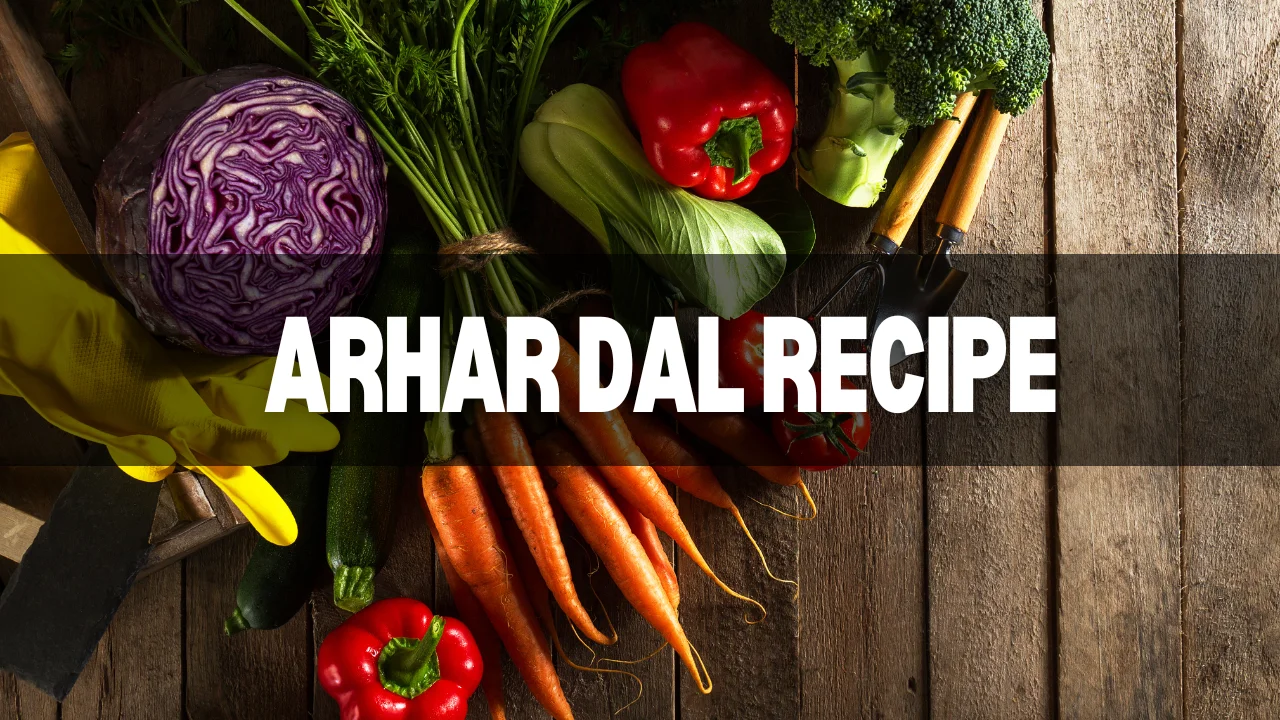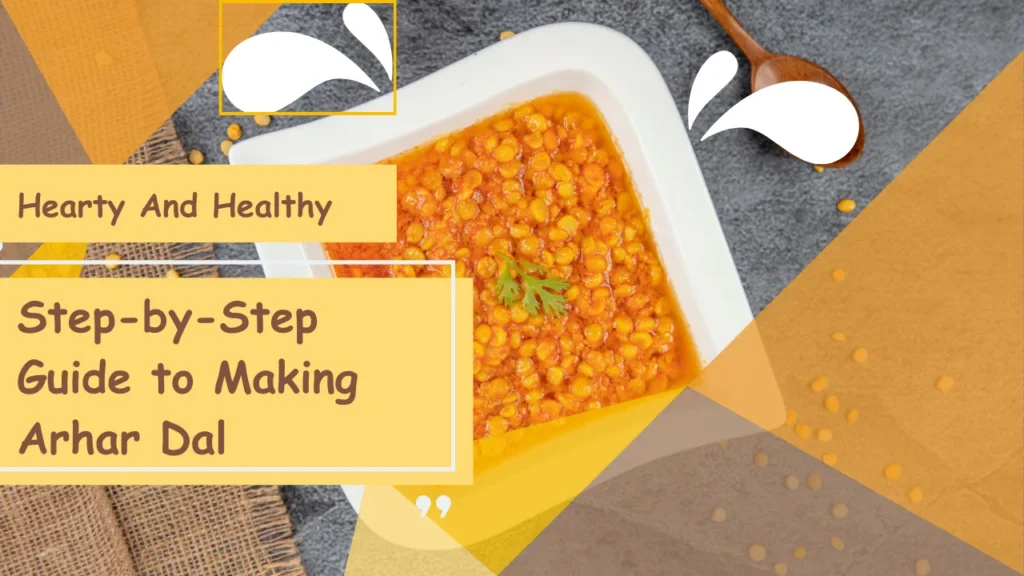Arhar Dal Recipe: A Staple Dish in Indian Kitchens

Arhar Dal Recipe is one of the most beloved and frequently cooked dishes in Indian households. Known for its simplicity and delightful taste, it’s a dish that’s both nutritious and easy to prepare. This humble lentil dish, made from toor dal or pigeon peas, can be found on almost every Indian dining table. Whether paired with steamed rice or hot rotis, the arhar dal recipe provides a comforting and satisfying meal for everyone.
What is Arhar Dal?
Arhar dal, also known as toor dal or pigeon peas, is a type of legume that is widely consumed in India. It is packed with essential nutrients like protein, fiber, vitamins, and minerals. The arhar dal recipe is a great source of energy and is known for its ability to keep you full for a longer period. Moreover, it’s a versatile dish, and can be made in several ways, depending on regional preferences. Some versions are more tangy, while others are mild and creamy.
Health Benefits of Arhar Dal
The arhar dal recipe is not just tasty but also highly nutritious. Rich in protein, it is often used as a meat substitute for vegetarians. Arhar dal is also an excellent source of dietary fiber, which helps in digestion and keeps the gut healthy. In addition, it provides a good amount of folic acid, essential for pregnant women and beneficial for maintaining heart health. Eating arhar dal regularly can also contribute to lowering cholesterol levels and stabilizing blood sugar, making it a great choice for diabetics.
Ingredients for Arhar Dal Recipe
To make a traditional arhar dal recipe, you don’t need too many ingredients. Most of them are likely already available in your kitchen pantry. The basic ingredients are as follows:
- 1 cup of arhar dal (toor dal)
- 2 cups of water
- 1 onion, chopped
- 1 tomato, chopped
- 1 teaspoon turmeric powder
- 1 teaspoon cumin seeds
- 2-3 green chilies, slit
- 1 teaspoon ginger-garlic paste
- Salt to taste
- Ghee or oil for tempering
- Fresh coriander leaves for garnish
These simple ingredients come together to create a flavorful and healthy arhar dal recipe that is perfect for any meal.
Also Read: Labsys Health Kerala Department of Health and Family Welfare

Step-by-Step Guide to Making Arhar Dal
Now that you have gathered the ingredients, let’s walk through the steps for preparing the arhar dal recipe:
1. Preparing the Dal
Rinse the arhar dal thoroughly under running water. Soak it for about 20 minutes, which will help the dal cook faster and more evenly. Once soaked, transfer the dal to a pressure cooker, add two cups of water, turmeric, and a pinch of salt. Cook the dal for 4-5 whistles or until the dal is soft and well-cooked.
2. Making the Tempering (Tadka)
In Indian cuisine, tempering or “tadka” adds flavor to the dal. Heat some ghee or oil in a pan and add cumin seeds. Once they start to crackle, add chopped onions, green chilies, and ginger-garlic paste. Sauté them until the onions turn golden brown. Add chopped tomatoes and cook until they become soft and mushy.
3. Combining Dal with Tempering
Once the tomatoes are cooked, pour the tempered mixture into the cooked dal. Stir well to combine the flavors. You can adjust the consistency by adding a bit more water if you prefer a thinner dal. Let the dal simmer for another 5-10 minutes on low heat to allow the flavors to meld together.
Serving Suggestions for Arhar Dal
The beauty of the arhar dal recipe is in its versatility. It can be served with a variety of side dishes and accompaniments. Here are some ways you can enjoy this delicious dal:
- With Steamed Rice: This is the most common way to enjoy arhar dal. The soft dal pairs perfectly with plain, fluffy rice.
- With Rotis or Parathas: If you prefer bread over rice, then serving this dal with roti or paratha is an excellent option.
- With a Vegetable Stir-Fry: Many people love pairing their dal with a vegetable stir-fry or sabzi for a complete meal.
Nutritional Information of Arhar Dal
To give you a better understanding of the health benefits, here’s a breakdown of the nutritional content of the arhar dal recipe per serving:
| Nutrient | Amount per Serving |
|---|---|
| Calories | 185 kcal |
| Protein | 12 grams |
| Fiber | 8 grams |
| Carbohydrates | 33 grams |
| Fat | 2 grams |
| Sodium | 10 mg |
| Potassium | 370 mg |
This nutritional profile makes arhar dal an excellent choice for those looking to include more plant-based proteins in their diet.
Tips to Perfect Your Arhar Dal Recipe
Making a perfect arhar dal recipe may seem simple, but a few tips can help elevate your dish to the next level:
- Consistency: The consistency of your dal should be according to your preference. If you like your dal thick, simmer it longer. If you prefer it thinner, add some water.
- Spices: Adjust the amount of spices according to your taste. Some regions in India prefer spicier dal, while others like it mild.
- Ghee for Tempering: Using ghee instead of oil adds a rich and authentic flavor to the dal.
- Lemon Juice: A dash of lemon juice just before serving can add a zesty freshness to the dish.
- Fresh Herbs: Always garnish your dal with fresh coriander leaves to enhance the aroma and taste.
Regional Variations of Arhar Dal Recipe
Arhar dal is made in several unique ways across India, each region adding its own special touch:
- North Indian Arhar Dal: In the northern states, arhar dal is often made with a tempering of ghee, cumin seeds, and asafoetida (hing). This version usually includes garam masala and sometimes a dash of dried fenugreek leaves (kasuri methi) to add extra flavor.
- South Indian Sambar: In South India, arhar dal is used to make the famous sambar. This dish is prepared with a tamarind base, vegetables like drumstick and pumpkin, and a blend of spices like mustard seeds, curry leaves, and sambar powder.
- Maharashtrian Varan: In Maharashtra, arhar dal is cooked as “varan.” This dish is simpler, with a light tempering of ghee, cumin, and turmeric, often served with rice and a dollop of ghee.
- Bengali Arhar Dal: In Bengal, the dal is made with a tempering of mustard oil, panch phoron (a blend of five spices: fennel, cumin, mustard, nigella seeds, and fenugreek), and green chilies. This version has a unique and slightly sharp flavor.
Serving Arhar Dal with Traditional Indian Accompaniments
In traditional Indian meals, arhar dal is not served alone. Here are some traditional accompaniments that go perfectly with this dish:
- Pickles: A spicy Indian pickle, made from mangoes, lime, or chilies, adds a tangy and spicy kick to the mild flavors of the dal.
- Papad: Fried or roasted papad (thin crispy flatbreads made from lentils) adds crunch to the meal.
- Chutneys: Coriander chutney or coconut chutney are often served with arhar dal in different regions.
- Fried Vegetables: Vegetables like aloo bhindi (potatoes with okra) or baingan bharta (mashed roasted eggplant) pair well with the creamy dal.
Cooking Techniques for Perfect Arhar Dal
To further improve the authenticity and flavor of your arhar dal recipe, these traditional techniques can help:
- Pressure Cooking: Pressure cooking is the most common method of preparing arhar dal in India, as it saves time and ensures the dal is cooked perfectly. However, traditionally, some people slow-cook the dal over low heat, which allows the flavors to blend better.
- Smoky Flavor with Dhungar Method: In some households, a unique technique called the Dhungar method is used to impart a smoky flavor to the dal. After the dal is cooked, a small piece of charcoal is heated until red-hot. It is placed in a small metal container in the middle of the dal, and a spoonful of ghee is poured over the charcoal. The pot is then covered, allowing the smoke to infuse the dal for a couple of minutes.
- The Right Ghee and Spices Balance: The balance of spices is key to an authentic arhar dal recipe. The tempering should be done in ghee, which gives the dish an authentic and rich flavor. The use of spices like cumin, mustard seeds, and hing is traditional in most versions of the dal.
Cultural Significance of Arhar Dal
In Indian culture, arhar dal holds a significant place, especially during festivals and religious rituals. In some parts of India, this dish is prepared as a part of festive meals like Diwali or Navratri. It is also considered auspicious in weddings, where it is often served with other traditional dishes as part of the wedding feast. Additionally, for vegetarians in India, arhar dal is a primary source of protein, making it an essential part of their daily diet.
By understanding these authentic touches, variations, and cultural significance, you can further enrich your arhar dal recipe, making it not just a dish but a representation of Indian culinary tradition.
Conclusion
The arhar dal recipe is a timeless dish that holds a special place in Indian cuisine. It is not only delicious but also incredibly nutritious. Whether you’re looking to cook a comforting meal after a long day or impress your guests with a traditional Indian dish, this arhar dal recipe is perfect for any occasion. The best part is that it’s easy to make, requires minimal ingredients, and can be customized according to your taste preferences.
Also Read: Comprehensive Guide to the SBI Health Insurance Premium Chart PDF
So, the next time you’re in the mood for a hearty and healthy meal, try out this arhar dal recipe. You’ll be sure to love it, and it may even become a regular in your kitchen rotation!






